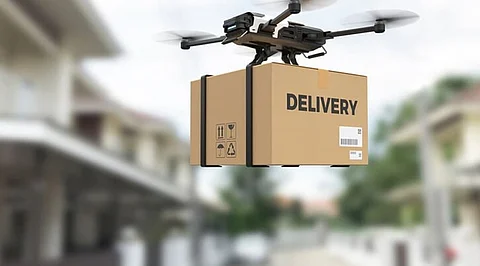
- Insights
- Cryptocurrencies
- Stocks
- White Papers
- Industry
- Geography
- Insights
- Cryptocurrencies
- Stocks
- White Papers
- Industry
- Geography


In the bustling world of e-commerce, the race to perfect the delivery experience has reached new heights – quite literally. As consumers demand faster, more convenient shipping options, companies are turning to the skies, harnessing the power of drones to revolutionize the way packages are delivered to our doorsteps. From urban centers to remote rural areas, drone delivery is swiftly becoming a reality, promising to redefine parcel tracking and the last mile of logistics to reshape the future of commerce.
At the heart of this transformation lies the concept of autonomous flying machines – drones designed to navigate airspace and deliver packages with unparalleled speed and efficiency. These unmanned aerial vehicles (UAVs) are equipped with advanced technology, including GPS navigation, artificial intelligence, and computer vision systems, allowing them to autonomously navigate their surroundings and safely deliver payloads to their intended destinations.
The process begins when a customer submits an order online. Once the order is processed and packaged, it is loaded onto a drone stationed at a nearby distribution center. With a click of a button, the drone takes off, soaring through the sky towards its designated drop-off point. Along the way, it carefully avoids obstacles and adjusts its flight path in real-time, ensuring a smooth and seamless delivery experience.
What sets drone delivery apart is its ability to bypass the challenges typically associated with ground transportation. Unlike traditional delivery methods, drones are not bound by traffic congestion, road closures, or unpredictable weather conditions. Instead, they offer a direct, point-to-point delivery solution that significantly reduces transit times and increases delivery speeds.
But the benefits of drone delivery extend beyond mere convenience. For consumers eager to track the progress of their packages, companies like Ordertracker and 17track offer real-time package tracking, allowing users to monitor their deliveries from takeoff to touchdown. With just a few clicks, customers can access up-to-the-minute information about their package's whereabouts, ensuring peace of mind and transparency throughout the delivery process.
Moreover, drone delivery holds the promise of improved sustainability. In a world increasingly concerned with reducing carbon emissions and minimizing environmental impact, drones offer a greener alternative to traditional delivery methods. Studies have shown that drones emit fewer carbon emissions and consume less energy than delivery trucks and vans, particularly during last-mile deliveries. By embracing drone technology, companies can not only enhance their operational efficiency but also contribute to a more sustainable future.
One of the most exciting aspects of drone delivery is its potential to reach areas that are traditionally underserved by traditional transportation networks. In rural communities and remote regions where access to goods and services is limited, drones offer a lifeline, delivering essential supplies and medical equipment to those in need. Whether it's delivering medical supplies to remote clinics or bringing groceries to isolated villages, drones have the power to bridge the gap and improve accessibility for all.
However, the road to widespread adoption of drone delivery is not without its challenges. Regulatory hurdles, safety concerns, and public acceptance are all factors that must be addressed before drones can truly take flight. In the United States, in particular, strict regulations from the Federal Aviation Administration (FAA) govern the operation of drones, requiring companies to navigate a complex web of rules and restrictions. Moreover, concerns about privacy, security, and airspace management loom large, raising questions about the long-term viability and scalability of drone delivery systems.
Despite these challenges, the future of drone delivery looks promising. Companies around the world are investing heavily in research and development, pushing the boundaries of what's possible and laying the groundwork for a future where drones are as ubiquitous as mail trucks. As technology continues to evolve and regulations evolve, we can expect to see drones playing an increasingly important role in the delivery ecosystem, reshaping the way we shop, ship, and receive goods in the years to come.
